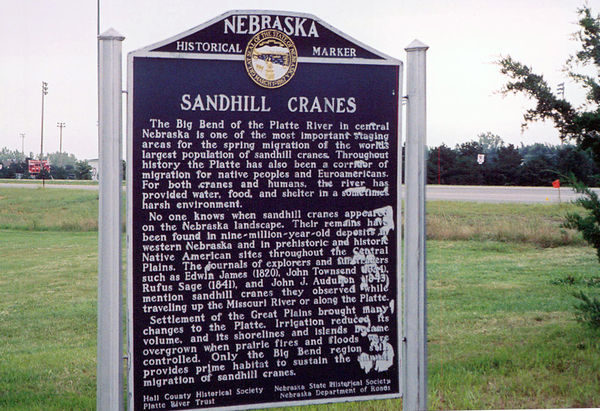Difference between revisions of "Nebraska Historical Marker: Sandhill Cranes"
m |
|||
| Line 2: | Line 2: | ||
==Location== | ==Location== | ||
| − | + | 2 miles south of I-80 Alda Interchange, mm 305, on Alda Road, Hall County, Nebraska | |
| − | View this marker's location '''[https:// | + | View this marker's location '''[https://www.google.com/maps/place/40%C2%B046'19.6%22N+98%C2%B029'34.9%22W/@40.7740883,-98.4979243,2220m/data=!3m1!1e3!4m5!3m4!1s0x0:0x0!8m2!3d40.772119!4d-98.493038?hl=en 40.772119, -98.493038]''' |
View a map of all Nebraska historical markers, '''[http://www.nebraskahistory.org/publish/markers/texts/index.shtml Browse Historical Marker Map]''' | View a map of all Nebraska historical markers, '''[http://www.nebraskahistory.org/publish/markers/texts/index.shtml Browse Historical Marker Map]''' | ||
==Marker Text== | ==Marker Text== | ||
| − | ''The Big Bend of the Platte River in central Nebraska is one of the most important staging areas | + | ''The Big Bend of the Platte River in central Nebraska is one of the most important staging areas for the spring migration of the world's largest population of sandhill cranes. Throughout history the Platte has also been a corridor of migration for native peoples and Euro-americans. For both cranes and humans, the river has provided water, food, and shelter in a sometimes harsh environment. |
| − | for the spring migration of the world's largest population of sandhill cranes. Throughout history | + | |
| − | the Platte has also been a corridor of migration for native peoples and | + | ''No one knows when sandhill cranes appeared on the Nebraska landscape. Their remains have been found in nine-million-year-old deposits in western Nebraska and in prehistoric and historic Native American sites throughout the central plains. The journals of explorers and fur traders such as Edwin James (1820), John Townsend (1834), Rufus Sage (1841), and John J. Audubon (1843) mention sandhill cranes they observed while traveling up the Missouri River or along the Platte. |
| − | cranes and humans, the river has provided water, food, and shelter in a sometimes harsh | + | |
| − | environment. | + | ''Settlement of the Great Plains brought many changes to the Platte. Irrigation reduced its volume, and its shorelines and islands became overgrown when prairie fires and floods were controlled. Only the Big Bend region still provides prime habitat to sustain the annual migration of sandhill cranes. |
| − | ''No one knows when sandhill cranes appeared on the Nebraska landscape. Their remains have | + | |
| − | been found in nine-million-year-old deposits in western Nebraska and in prehistoric and historic | + | |
| − | Native American sites throughout the central plains. The journals of explorers and fur traders | + | |
| − | such as Edwin James (1820), John Townsend (1834), Rufus Sage (1841), and John J. Audubon | + | |
| − | (1843) mention sandhill cranes they observed while traveling up the Missouri River or along the | + | |
| − | Platte. | + | |
| − | ''Settlement of the Great Plains brought many changes to the Platte. Irrigation reduced its volume, | + | |
| − | and its shorelines and islands became overgrown when prairie fires and floods were controlled. | + | |
| − | Only the Big Bend region still provides prime habitat to sustain the annual migration of sandhill | + | |
| − | cranes. | + | |
==Further Information== | ==Further Information== | ||
Revision as of 08:28, 5 April 2017
Location
2 miles south of I-80 Alda Interchange, mm 305, on Alda Road, Hall County, Nebraska
View this marker's location 40.772119, -98.493038
View a map of all Nebraska historical markers, Browse Historical Marker Map
Marker Text
The Big Bend of the Platte River in central Nebraska is one of the most important staging areas for the spring migration of the world's largest population of sandhill cranes. Throughout history the Platte has also been a corridor of migration for native peoples and Euro-americans. For both cranes and humans, the river has provided water, food, and shelter in a sometimes harsh environment.
No one knows when sandhill cranes appeared on the Nebraska landscape. Their remains have been found in nine-million-year-old deposits in western Nebraska and in prehistoric and historic Native American sites throughout the central plains. The journals of explorers and fur traders such as Edwin James (1820), John Townsend (1834), Rufus Sage (1841), and John J. Audubon (1843) mention sandhill cranes they observed while traveling up the Missouri River or along the Platte.
Settlement of the Great Plains brought many changes to the Platte. Irrigation reduced its volume, and its shorelines and islands became overgrown when prairie fires and floods were controlled. Only the Big Bend region still provides prime habitat to sustain the annual migration of sandhill cranes.
Further Information
Bibliography
Marker program
See the Nebraska Historical Marker Program for more information.
